Douwe Kiela
Great Models Think Alike and this Undermines AI Oversight
Feb 06, 2025Abstract:As Language Model (LM) capabilities advance, evaluating and supervising them at scale is getting harder for humans. There is hope that other language models can automate both these tasks, which we refer to as "AI Oversight". We study how model similarity affects both aspects of AI oversight by proposing a probabilistic metric for LM similarity based on overlap in model mistakes. Using this metric, we first show that LLM-as-a-judge scores favor models similar to the judge, generalizing recent self-preference results. Then, we study training on LM annotations, and find complementary knowledge between the weak supervisor and strong student model plays a crucial role in gains from "weak-to-strong generalization". As model capabilities increase, it becomes harder to find their mistakes, and we might defer more to AI oversight. However, we observe a concerning trend -- model mistakes are becoming more similar with increasing capabilities, pointing to risks from correlated failures. Our work underscores the importance of reporting and correcting for model similarity, especially in the emerging paradigm of AI oversight.
LMUnit: Fine-grained Evaluation with Natural Language Unit Tests
Dec 17, 2024Abstract:As language models become integral to critical workflows, assessing their behavior remains a fundamental challenge -- human evaluation is costly and noisy, while automated metrics provide only coarse, difficult-to-interpret signals. We introduce natural language unit tests, a paradigm that decomposes response quality into explicit, testable criteria, along with a unified scoring model, LMUnit, which combines multi-objective training across preferences, direct ratings, and natural language rationales. Through controlled human studies, we show this paradigm significantly improves inter-annotator agreement and enables more effective LLM development workflows. LMUnit achieves state-of-the-art performance on evaluation benchmarks (FLASK, BigGenBench) and competitive results on RewardBench. These results validate both our proposed paradigm and scoring model, suggesting a promising path forward for language model evaluation and development.
Nearest Neighbor Normalization Improves Multimodal Retrieval
Oct 31, 2024



Abstract:Multimodal models leverage large-scale pre-training to achieve strong but still imperfect performance on tasks such as image captioning, visual question answering, and cross-modal retrieval. In this paper, we present a simple and efficient method for correcting errors in trained contrastive image-text retrieval models with no additional training, called Nearest Neighbor Normalization (NNN). We show an improvement on retrieval metrics in both text retrieval and image retrieval for all of the contrastive models that we tested (CLIP, BLIP, ALBEF, SigLIP, BEiT) and for both of the datasets that we used (MS-COCO and Flickr30k). NNN requires a reference database, but does not require any training on this database, and can even increase the retrieval accuracy of a model after finetuning.
OLMoE: Open Mixture-of-Experts Language Models
Sep 03, 2024



Abstract:We introduce OLMoE, a fully open, state-of-the-art language model leveraging sparse Mixture-of-Experts (MoE). OLMoE-1B-7B has 7 billion (B) parameters but uses only 1B per input token. We pretrain it on 5 trillion tokens and further adapt it to create OLMoE-1B-7B-Instruct. Our models outperform all available models with similar active parameters, even surpassing larger ones like Llama2-13B-Chat and DeepSeekMoE-16B. We present various experiments on MoE training, analyze routing in our model showing high specialization, and open-source all aspects of our work: model weights, training data, code, and logs.
Anchored Preference Optimization and Contrastive Revisions: Addressing Underspecification in Alignment
Aug 12, 2024



Abstract:Large Language Models (LLMs) are often aligned using contrastive alignment objectives and preference pair datasets. The interaction between model, paired data, and objective makes alignment a complicated procedure, sometimes producing subpar results. We study this and find that (i) preference data gives a better learning signal when the underlying responses are contrastive, and (ii) alignment objectives lead to better performance when they specify more control over the model during training. Based on these insights, we introduce Contrastive Learning from AI Revisions (CLAIR), a data-creation method which leads to more contrastive preference pairs, and Anchored Preference Optimization (APO), a controllable and more stable alignment objective. We align Llama-3-8B-Instruct using various comparable datasets and alignment objectives and measure MixEval-Hard scores, which correlate highly with human judgments. The CLAIR preferences lead to the strongest performance out of all datasets, and APO consistently outperforms less controllable objectives. Our best model, trained on 32K CLAIR preferences with APO, improves Llama-3-8B-Instruct by 7.65%, closing the gap with GPT4-turbo by 45%. Our code is available at https://github.com/ContextualAI/CLAIR_and_APO.
Lynx: An Open Source Hallucination Evaluation Model
Jul 11, 2024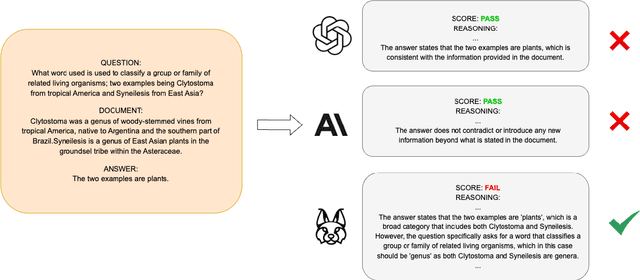
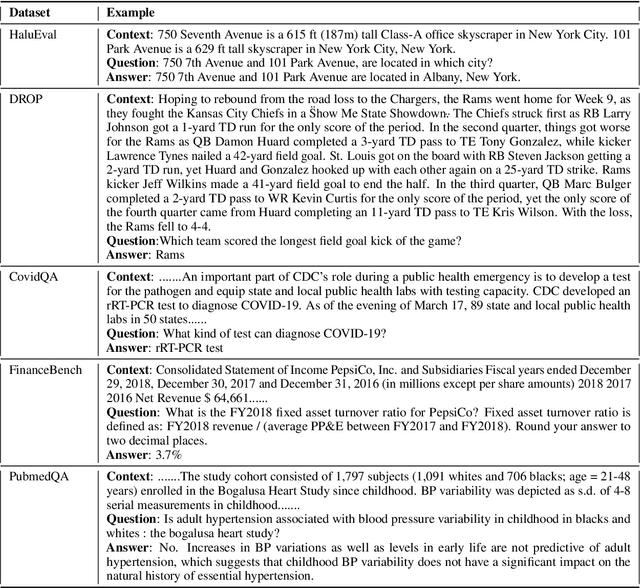
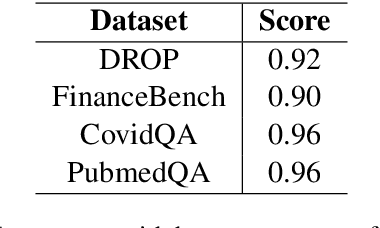

Abstract:Retrieval Augmented Generation (RAG) techniques aim to mitigate hallucinations in Large Language Models (LLMs). However, LLMs can still produce information that is unsupported or contradictory to the retrieved contexts. We introduce LYNX, a SOTA hallucination detection LLM that is capable of advanced reasoning on challenging real-world hallucination scenarios. To evaluate LYNX, we present HaluBench, a comprehensive hallucination evaluation benchmark, consisting of 15k samples sourced from various real-world domains. Our experiment results show that LYNX outperforms GPT-4o, Claude-3-Sonnet, and closed and open-source LLM-as-a-judge models on HaluBench. We release LYNX, HaluBench and our evaluation code for public access.
Generative Representational Instruction Tuning
Feb 15, 2024Abstract:All text-based language problems can be reduced to either generation or embedding. Current models only perform well at one or the other. We introduce generative representational instruction tuning (GRIT) whereby a large language model is trained to handle both generative and embedding tasks by distinguishing between them through instructions. Compared to other open models, our resulting GritLM 7B sets a new state of the art on the Massive Text Embedding Benchmark (MTEB) and outperforms all models up to its size on a range of generative tasks. By scaling up further, GritLM 8x7B outperforms all open generative language models that we tried while still being among the best embedding models. Notably, we find that GRIT matches training on only generative or embedding data, thus we can unify both at no performance loss. Among other benefits, the unification via GRIT speeds up Retrieval-Augmented Generation (RAG) by > 60% for long documents, by no longer requiring separate retrieval and generation models. Models, code, etc. are freely available at https://github.com/ContextualAI/gritlm.
KTO: Model Alignment as Prospect Theoretic Optimization
Feb 02, 2024



Abstract:Kahneman & Tversky's $\textit{prospect theory}$ tells us that humans perceive random variables in a biased but well-defined manner; for example, humans are famously loss-averse. We show that objectives for aligning LLMs with human feedback implicitly incorporate many of these biases -- the success of these objectives (e.g., DPO) over cross-entropy minimization can partly be ascribed to them being $\textit{human-aware loss functions}$ (HALOs). However, the utility functions these methods attribute to humans still differ from those in the prospect theory literature. Using a Kahneman-Tversky model of human utility, we propose a HALO that directly maximizes the utility of generations instead of maximizing the log-likelihood of preferences, as current methods do. We call this approach Kahneman-Tversky Optimization (KTO), and it matches or exceeds the performance of preference-based methods at scales from 1B to 30B. Crucially, KTO does not need preferences -- only a binary signal of whether an output is desirable or undesirable for a given input. This makes it far easier to use in the real world, where preference data is scarce and expensive.
I am a Strange Dataset: Metalinguistic Tests for Language Models
Jan 10, 2024



Abstract:Statements involving metalinguistic self-reference ("This paper has six sections.") are prevalent in many domains. Can large language models (LLMs) handle such language? In this paper, we present "I am a Strange Dataset", a new dataset for addressing this question. There are two subtasks: generation and verification. In generation, models continue statements like "The penultimate word in this sentence is" (where a correct continuation is "is"). In verification, models judge the truth of statements like "The penultimate word in this sentence is sentence." (false). We also provide minimally different metalinguistic non-self-reference examples to complement the main dataset by probing for whether models can handle metalinguistic language at all. The dataset is hand-crafted by experts and validated by non-expert annotators. We test a variety of open-source LLMs (7B to 70B parameters) as well as closed-source LLMs through APIs. All models perform close to chance across both subtasks and even on the non-self-referential metalinguistic control data, though we find some steady improvement with model scale. GPT 4 is the only model to consistently do significantly better than chance, and it is still only in the 60% range, while our untrained human annotators score well in the 89-93% range. The dataset and evaluation toolkit are available at https://github.com/TristanThrush/i-am-a-strange-dataset.
Leveraging Diffusion Perturbations for Measuring Fairness in Computer Vision
Nov 25, 2023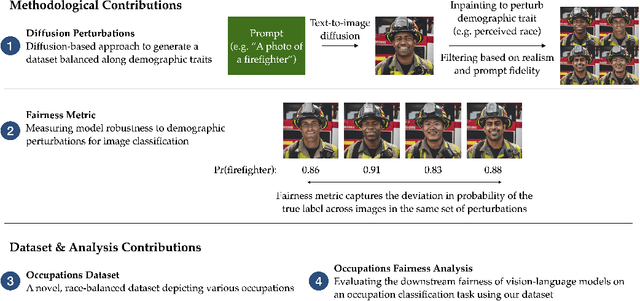
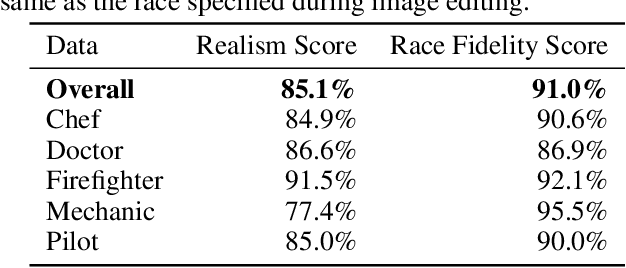
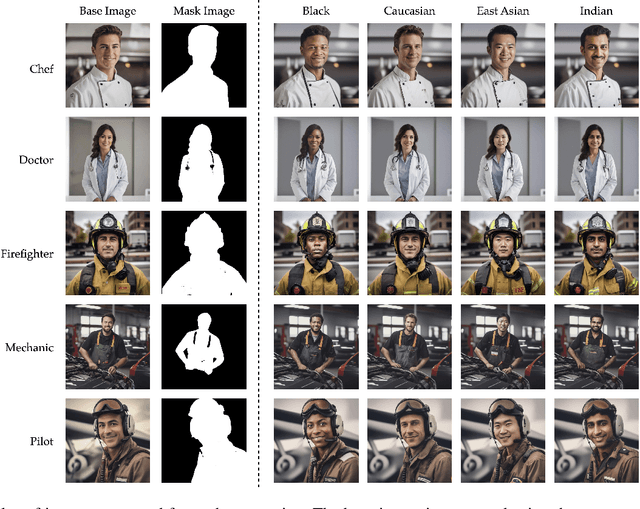
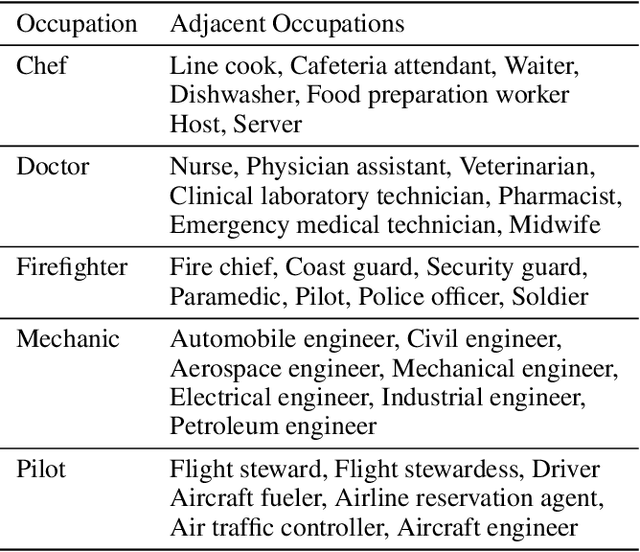
Abstract:Computer vision models have been known to encode harmful biases, leading to the potentially unfair treatment of historically marginalized groups, such as people of color. However, there remains a lack of datasets balanced along demographic traits that can be used to evaluate the downstream fairness of these models. In this work, we demonstrate that diffusion models can be leveraged to create such a dataset. We first use a diffusion model to generate a large set of images depicting various occupations. Subsequently, each image is edited using inpainting to generate multiple variants, where each variant refers to a different perceived race. Using this dataset, we benchmark several vision-language models on a multi-class occupation classification task. We find that images generated with non-Caucasian labels have a significantly higher occupation misclassification rate than images generated with Caucasian labels, and that several misclassifications are suggestive of racial biases. We measure a model's downstream fairness by computing the standard deviation in the probability of predicting the true occupation label across the different perceived identity groups. Using this fairness metric, we find significant disparities between the evaluated vision-and-language models. We hope that our work demonstrates the potential value of diffusion methods for fairness evaluations.
 Add to Chrome
Add to Chrome Add to Firefox
Add to Firefox Add to Edge
Add to Edge